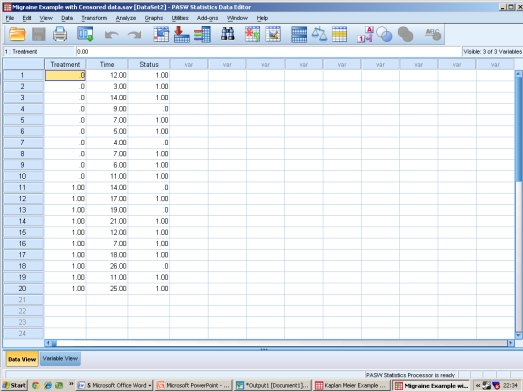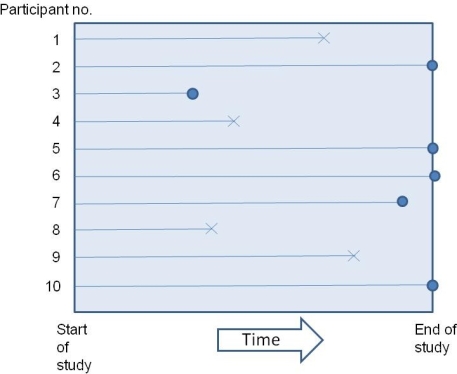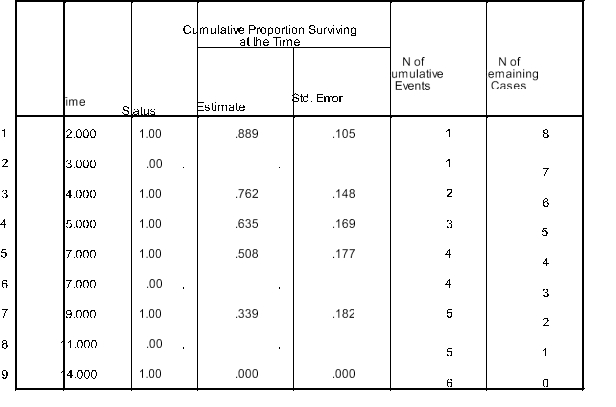A) the instantaneous rate of survival at any time point
B) the instantaneous rate of event at any time point
C) the instantaneous rate of censoring at any time point
D) any of the above
F) B) and D)
Correct Answer

verified
B
Correct Answer
verified
Multiple Choice
Which probability distribution is used by the Mantel-Cox test to calculate the p-values?
A) The standard normal distribution
B) The binomial distribution
C) The t distribution
D) The chi-square distribution
F) A) and C)
Correct Answer

verified
D
Correct Answer
verified
Multiple Choice
In the following SPSS screenshot what does the third column represent? 
A) Whether or not the participants are employed
B) Whether or not the participants were randomised into the study
C) Whether or not the participants received the treatment
D) Whether or not the participants experienced the event of interest during the study
F) All of the above
Correct Answer

verified
Correct Answer
verified
Multiple Choice
According to the following hazard curves which group experiences the earlier increase in the rate of Migraines? 
A) The regular treatment condition
B) The new Migraine treatment
C) Both treatments experience the same rate of increase in Migraines
D) None of the above
F) A) and D)
Correct Answer

verified
Correct Answer
verified
Multiple Choice
What is a survival curve?
A) A plot of the actual time taken for everyone to experience the event of interest
B) A plot of the number of participants who are randomised into the study
C) A plot of the proportion of participants who do not experience the event of interest over the time of the study
D) None of the above
F) A) and C)
Correct Answer

verified
Correct Answer
verified
Multiple Choice
Which of the following terms is given to a participant who does not experience the event of interest in a survival analysis?
A) A survivor
B) A case
C) A censored case
D) None of the above
F) All of the above
Correct Answer

verified
C
Correct Answer
verified
Multiple Choice
What is the additional benefit over a standard survival curve offered by Kaplan-Meir curves?
A) They are easier to plot
B) They take account of censored cases at each relevant time-point
C) They are easier to understand
D) All of the above
F) All of the above
Correct Answer

verified
Correct Answer
verified
Multiple Choice
In the following graph how many cases are right censored? 
A) 10
B) 5
C) 6
D) 4
F) All of the above
Correct Answer

verified
Correct Answer
verified
Multiple Choice
What is the purpose of the Log Rank test?
A) To look at difference in number of participants who do not experience an event of interest
B) To calculate the proportion of censored data in survival analysis
C) To investigate differences between survival curves
D) None of the above
F) B) and C)
Correct Answer

verified
Correct Answer
verified
Multiple Choice
According to the following survival table how many censored cases are there? 

A) 1
B) 2
C) 3
D) 4
F) A) and B)
Correct Answer

verified
Correct Answer
verified
Showing 1 - 10 of 10
Related Exams